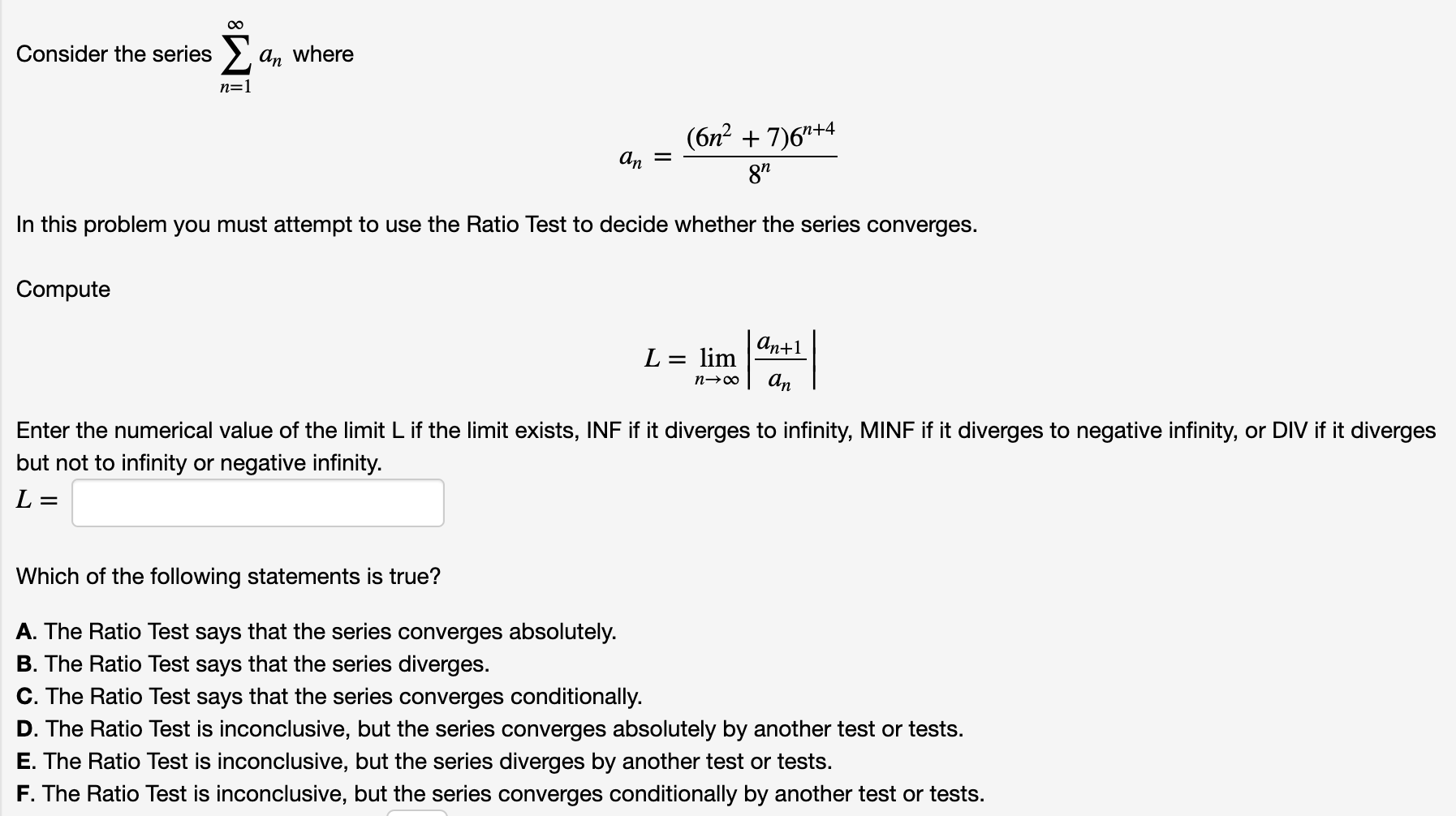Consider the series an where n=1 (6n² + 7)6"+4 8" In this problem you must attempt to use the Ratio Test to decide whether the series converges. Compute An+1 L = lim An п>0 Enter the numerical value of the limit L if the limit exists, INF if it diverges to infinity, MINF if it diverges to negative infinity, or DIV if it diverges but not to infinity or negative infinity. L = Which of the following statements is true? A. The Ratio Test says that the series converges absolutely. B. The Ratio Test says that the series diverges. C. The Ratio Test says that the series converges conditionally. D. The Ratio Test is inconclusive, but the series converges absolutely by another test or tests. E. The Ratio Test is inconclusive, but the series diverges by another test or tests. F. The Ratio Test is inconclusive, but the series converges conditionally by another test or tests.
Consider the series an where n=1 (6n² + 7)6"+4 8" In this problem you must attempt to use the Ratio Test to decide whether the series converges. Compute An+1 L = lim An п>0 Enter the numerical value of the limit L if the limit exists, INF if it diverges to infinity, MINF if it diverges to negative infinity, or DIV if it diverges but not to infinity or negative infinity. L = Which of the following statements is true? A. The Ratio Test says that the series converges absolutely. B. The Ratio Test says that the series diverges. C. The Ratio Test says that the series converges conditionally. D. The Ratio Test is inconclusive, but the series converges absolutely by another test or tests. E. The Ratio Test is inconclusive, but the series diverges by another test or tests. F. The Ratio Test is inconclusive, but the series converges conditionally by another test or tests.
Calculus: Early Transcendentals
8th Edition
ISBN:9781285741550
Author:James Stewart
Publisher:James Stewart
Chapter1: Functions And Models
Section: Chapter Questions
Problem 1RCC: (a) What is a function? What are its domain and range? (b) What is the graph of a function? (c) How...
Related questions
Question

Transcribed Image Text:Consider the series
an where
n=1
(6n² + 7)6"+4
8"
In this problem you must attempt to use the Ratio Test to decide whether the series converges.
Compute
An+1
L = lim
An
п>0
Enter the numerical value of the limit L if the limit exists, INF if it diverges to infinity, MINF if it diverges to negative infinity, or DIV if it diverges
but not to infinity or negative infinity.
L =
Which of the following statements is true?
A. The Ratio Test says that the series converges absolutely.
B. The Ratio Test says that the series diverges.
C. The Ratio Test says that the series converges conditionally.
D. The Ratio Test is inconclusive, but the series converges absolutely by another test or tests.
E. The Ratio Test is inconclusive, but the series diverges by another test or tests.
F. The Ratio Test is inconclusive, but the series converges conditionally by another test or tests.
Expert Solution
This question has been solved!
Explore an expertly crafted, step-by-step solution for a thorough understanding of key concepts.
This is a popular solution!
Trending now
This is a popular solution!
Step by step
Solved in 4 steps with 3 images

Recommended textbooks for you

Calculus: Early Transcendentals
Calculus
ISBN:
9781285741550
Author:
James Stewart
Publisher:
Cengage Learning

Thomas' Calculus (14th Edition)
Calculus
ISBN:
9780134438986
Author:
Joel R. Hass, Christopher E. Heil, Maurice D. Weir
Publisher:
PEARSON

Calculus: Early Transcendentals (3rd Edition)
Calculus
ISBN:
9780134763644
Author:
William L. Briggs, Lyle Cochran, Bernard Gillett, Eric Schulz
Publisher:
PEARSON

Calculus: Early Transcendentals
Calculus
ISBN:
9781285741550
Author:
James Stewart
Publisher:
Cengage Learning

Thomas' Calculus (14th Edition)
Calculus
ISBN:
9780134438986
Author:
Joel R. Hass, Christopher E. Heil, Maurice D. Weir
Publisher:
PEARSON

Calculus: Early Transcendentals (3rd Edition)
Calculus
ISBN:
9780134763644
Author:
William L. Briggs, Lyle Cochran, Bernard Gillett, Eric Schulz
Publisher:
PEARSON

Calculus: Early Transcendentals
Calculus
ISBN:
9781319050740
Author:
Jon Rogawski, Colin Adams, Robert Franzosa
Publisher:
W. H. Freeman


Calculus: Early Transcendental Functions
Calculus
ISBN:
9781337552516
Author:
Ron Larson, Bruce H. Edwards
Publisher:
Cengage Learning